Tuesdays with Tony
For reasons unknown to me, horses simply love to injure their legs. Yet more proof that us cats are superior to horses, am I right? And they are so creative about it! Lameness or lacerations, tendonitis or trailer rides…there are many reasons why my docs might ask you to bandage your horse’s leg. If you don’t know how to do it, it can be a bit intimidating. And though bandaging is really useful, if done wrong it can actually do more harm than good. This week, I’m going to go through two of the most common bandages and the materials you’ll need for them. My doc will direct you on which one to use when she sees your horse, but if you follow my instructions, you’ll be well prepared!
Standing bandages
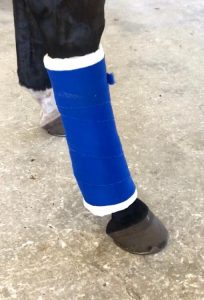 This is the most common type of bandage, applied around the horse’s lower leg from the top of the cannon bone down to the fetlock or pastern. The basic materials are a thick padding and a compressive bandage on top. A standing bandage is great for covering a wound, supporting an injured tendon, or controlling swelling. It’s also a good option for protecting your horse’s legs when trailering. Keep in mind, this is not the same thing as a polo wrap that you might ride a horse in. Let’s look at the layers first so you know what to have on hand.
This is the most common type of bandage, applied around the horse’s lower leg from the top of the cannon bone down to the fetlock or pastern. The basic materials are a thick padding and a compressive bandage on top. A standing bandage is great for covering a wound, supporting an injured tendon, or controlling swelling. It’s also a good option for protecting your horse’s legs when trailering. Keep in mind, this is not the same thing as a polo wrap that you might ride a horse in. Let’s look at the layers first so you know what to have on hand.
The quilt or “cotton” layer: It’s a thick, cushy padding. Even though it may be called a “cotton”, I do NOT mean the kind of cotton roll that pulls apart into bits. My doc uses that stuff for cleaning sheaths. She hates it for leg wraps, because it bunches up and causes pressure points or the little cotton fibers stick to the wound. You have 2 options for this bandage layer. One is a disposable product such as a combine roll that is commonly used in a hospital to cover a wound. This is only meant to be used once and can’t be washed.
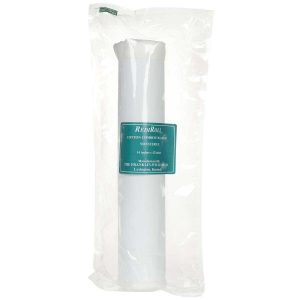
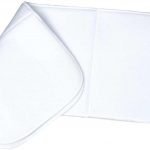
The other option is a fabric wrap like a quilt or “no-bow” bandage. These can be washed and reused indefinitely and are really useful to have around the barn. In my not-so-humble opinion, all horse people should own them. Don’t try to cut corners and use a thin padding or a towel for this purpose – you’re more likely to cause a skin or tendon injury if you don’t have sufficient padding.
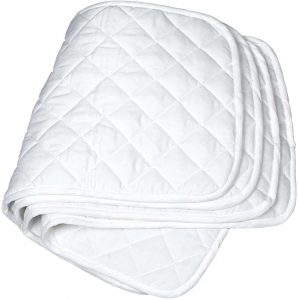
The outer compressive layer: This holds your quilt in place. You can use a disposable product such as Vetrap or a reusable stable bandage. You may be tempted to use a polo wrap, but it really doesn’t work very well.
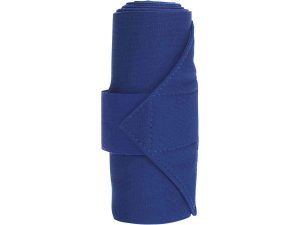
Optional: If your horse has a wound, you may also be using a thin bandage underneath the standing bandage, made up of a non-adherent pad and some white roll gauze. This can cover the wound without sticking to it and keep wound ointment in place.
Tips for putting on a standing bandage
- Despite what you have probably heard, it doesn’t actually matter which direction you wrap in! The convention is to wrap clockwise on the right leg and counterclockwise on the left, but you don’t have to. I know, I know, other horse people may judge you if they think you’re going in the wrong direction. But really, it’s a habit, rather than a medical necessity. You can be a rebel if you want to.
- When you buy a stable bandage, it will be all wrapped up nicely in the package with the Velcro on the outside. That’s useless for actually putting it on the horse. You will have to unroll it and re-roll it the right way. **This part is important to avoid much frustration and potential curse words**. When you roll the bandage, fold the Velcro ends towards each other and then roll the wrap with the Velcro towards the inside. That way, when you get to the end of your beautiful bandage, you won’t find that the Velcro is on the inside of the wrap and hence, not at all useful for securing the bandage.
- Pull firmly but not excessively. It’s helpful to practice this to get the right tension. Too loose and the bandage could slip down, but too tight and it can injure the skin or tendons. If your quilt layer is nice and thick, injury is less likely to happen.
- Smooth out the wrinkles as you apply the layers, so they don’t cause pressure points.
- For the compressive layer, each layer should overlap the last one by about 50%.
- Leave about an inch of the white padding layer exposed on the top and the bottom
- For safety, don’t sit on the ground when applying the wrap, just in case your horse objects. Horses wearing hind limb bandages will frequently lift their back legs high on the first few steps. Just keep him moving for a few steps and he will usually get over it.
Check out this video of one of our awesome Springhill technicians applying a beautiful standing wrap.
Hoof bandage
This bandage is really useful if your horse has a hoof abscess and you need to poultice his foot or protect it once the abscess has drained.
The materials you will need:
- A diaper. Not tiny baby sized, unless you have a tiny horse. A size 4 is about right for most horses.
- Some duct tape (gorilla tape works even better and won’t wear through as easily)
- Scissors
The steps:
- First, make a duct-tape patch. Tear off approximately 6 strips of duct tape roughly 12 inches long and place them side by side vertically. Then tear off another 6 strips and place them side by side horizontally, on top of the vertical strips. So you will have 2 layers of tape, going in different directions. It helps to stick the pieces of tape to a surface as you are making the patch, and then peel the patch off when all the layers are on. Pro tip – don’t do this on a surface you would be upset about peeling the paint off. In a pinch, your thigh will do.
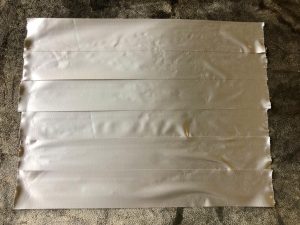
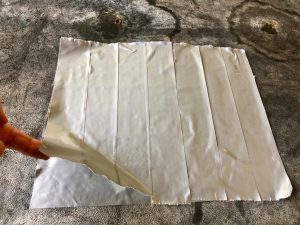
- Make a 2-inch cut on each of the corners
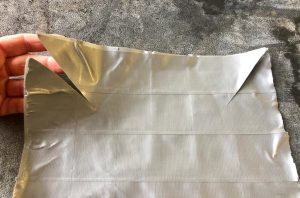
- Hold your horse’s foot up and apply whatever poultice or dressing is being used under the bandage (if any)
- Place the middle of the diaper on the bottom of the hoof and fold the top of the diaper around the pastern. Many diapers will have Velcro ends you can use to secure it.
- Place the middle of the duct tape patch on the bottom of the hoof. You may then find it easier to allow him to place his foot down and do the rest with him standing on the patch
- Fold each side upwards and overlap the cut corners snugly to fit the shape of his hoof. You should still have diaper extending further up than the duct tape reaches. This will protect the skin.
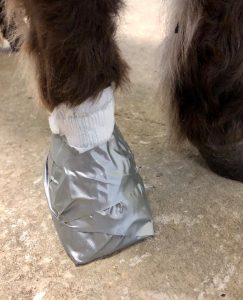
- Take the roll of duct tape and wrap it around the hoof so it secures the patch in place. Don’t pull too tightly over the heel bulbs. Make sure the diaper is high enough that the duct tape doesn’t contact the skin.
- Check the bottom of the hood bandage a couple times a day, as your horse will eventually wear through the bottom of the duct tape, depending how actively he is walking.
There are several other types of bandages you may need in specific situations, but my docs can show you those if your horse needs them. If you have a good handle on the standing wrap and the hoof bandage, you’ll be well prepared for most situations and will earn this cat’s nod of approval!
Until next week,
~Tony
P.S. Want more step-by-step videos? Check out my YouTube Channel! If you watch every video on there, you will be as smart as this cat. Well, almost.
Tuesdays with Tony is the official blog of Tony the Clinic Cat at Springhill Equine Veterinary Clinic in Newberry, Florida. For more information, please call us at (352) 472-1620, visit our website at SpringhillEquine.com, or follow us on Facebook!
[jetpack_subscription_form title="Subscribe to Whinny's Wisdoms"]

